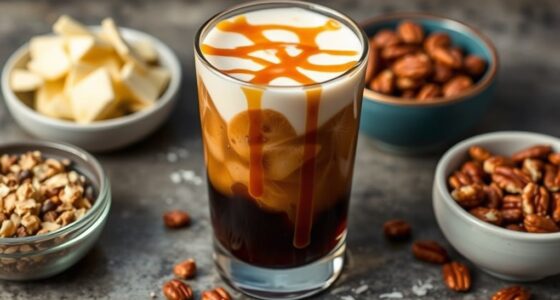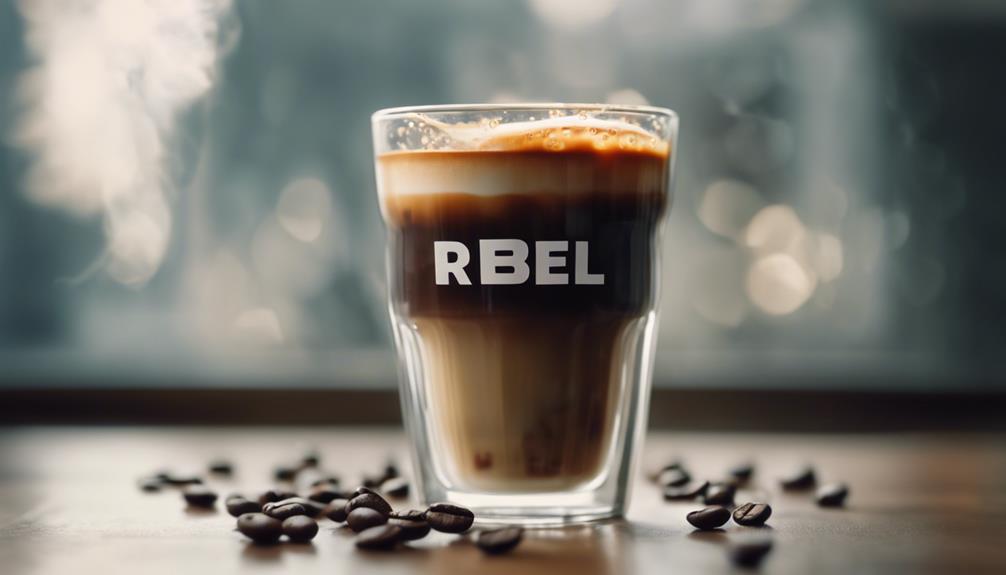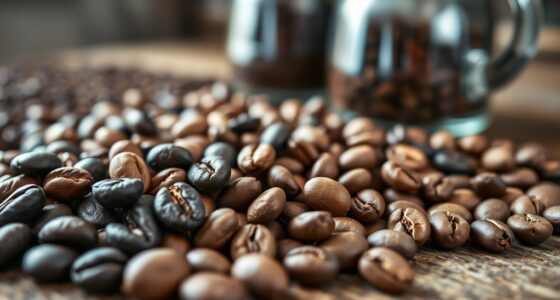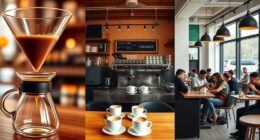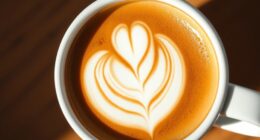To master advanced cold brew techniques, experiment with different extraction methods like immersion, cold drip, and Japanese-style pour-over to fine-tune flavor, strength, and clarity. Adjust brew ratios, steep times, and water flow for custom profiles. Using specialized equipment such as drip towers or pour-over setups allows precise control over each variable. Exploring these methods enhances complexity and richness in your brew—keep exploring further to reveal even more possibilities.
Key Takeaways
- Experiment with adjustable brew ratios and steeping times to customize flavor strength and acidity levels.
- Incorporate pre-infusion or agitation techniques during immersion to enhance extraction and complexity.
- Use temperature control, like room temperature versus refrigerated steeping, to influence flavor profiles.
- Combine cold brew with flavor additions such as spices, herbs, or fruit infusions for advanced flavor layering.
- Explore hybrid methods, like cold drip combined with post-brew hot pour-over, for nuanced taste and clarity.
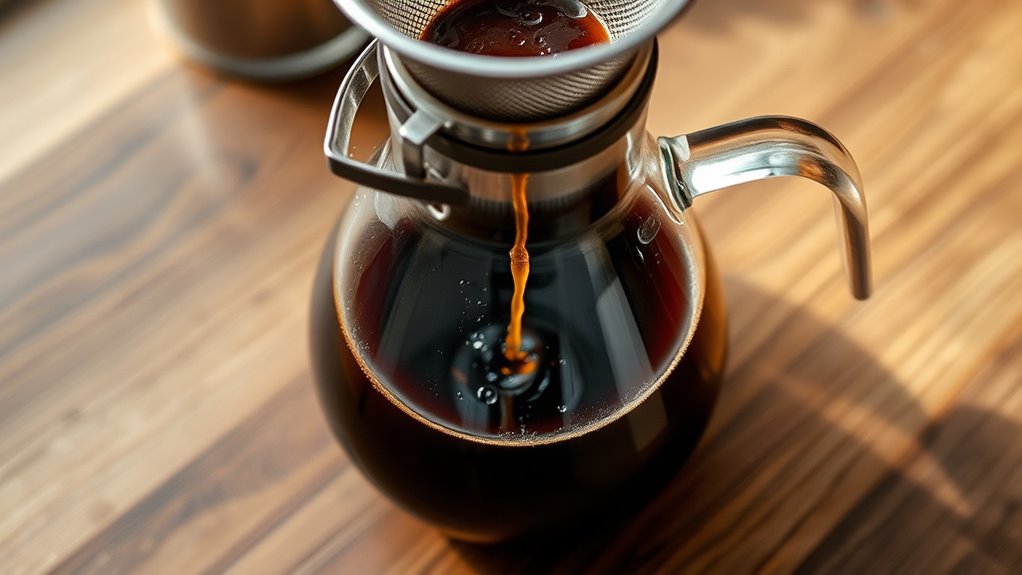
Are you curious about how different cold brew techniques can transform your coffee experience? When you explore methods like immersion, cold drip, and Japanese-style pour-over, you unlock a range of flavors and textures that go beyond standard brewing hot.
Each technique offers a unique approach to extracting the best qualities from your coffee grounds, with varying brew ratios, times, and equipment that influence the final flavor profile.
Each cold brew method uniquely enhances flavor through different ratios, times, and equipment choices.
Immersion cold brew is perhaps the most straightforward. You combine coarsely ground coffee with cold water, then steep it for 12 to 24 hours either at room temperature or in the refrigerator. This long brew time allows the coffee to develop a smooth, rich concentrate that’s often less acidic than hot-brewed coffee.
You can adjust your brew ratio to make a stronger concentrate or a more diluted drink, depending on how you prefer to enjoy it. Once brewed, this method yields a versatile base that can be served over ice, mixed with milk, or used as an ingredient in cocktails.
Because the coffee grounds steep directly in water, the extraction is thorough, producing a balanced, full-bodied flavor profile.
Cold drip brewing, on the other hand, relies on a slow, controlled drip of cold water over coffee grounds. This process can take several hours, often resulting in a concentrated brew with a complex, nuanced flavor and lower acidity.
The slow drip allows for precise control over the brew ratio and water flow, which influences the strength and clarity of the final product. Cold drip coffee tends to be richer and more intense, with a clean finish.
It’s ideal if you want a smooth, highly aromatic cold brew that emphasizes the coffee’s natural sweetness and depth.
The Japanese-style pour-over introduces a different twist. Instead of steeping, you brew hot coffee directly onto ice, which rapidly cools the extraction process.
This method produces a bright, clean iced coffee with a distinct flavor profile that highlights clarity and freshness. Since hot water extracts coffee more quickly than cold methods, you can control brew time to influence the flavor.
Adjusting the brew ratio and pouring technique allows you to craft a customized, vibrant iced coffee that’s perfect for hot days.
Frequently Asked Questions
How Do I Improve My Cold Brew?
To improve your cold brew, start by experimenting with different coffee-to-water ratios for a bolder or smoother taste.
Use fresh, high-quality beans, especially fruity varieties like Ethiopian, to enhance flavor.
Adjust steep times between 12-24 hours, and consider a hot bloom phase to boost extraction.
Fine-tune your grind to an extra coarse texture and taste-test regularly to find the perfect balance for your preferred flavor profile.
Can You Make Cold Brew in Advance?
Yes, you can definitely make cold brew in advance. Simply prepare it by steeping coffee grounds in water for 12-24 hours, then strain it.
Store the concentrate or brewed coffee in an airtight container in the fridge for up to two weeks. This way, you can enjoy fresh cold brew anytime.
Just remember to keep it sealed properly to maintain flavor and prevent spoilage.
What Can I Add to Cold Brew to Make It Taste Better?
To make your cold brew taste better, you can add natural flavorings like vanilla bean, cinnamon sticks, or cardamom pods to enhance aroma and depth.
Incorporate sweeteners such as honey or flavored syrups to balance tartness.
Mix in dairy or plant-based milk for creaminess, or infuse citrus peels and herbs like mint or basil for freshness.
Adjust brewing time or use fruitier coffee beans for a naturally richer flavor.
What Is the Golden Ratio for Cold Brew Coffee?
The golden ratio for cold brew coffee depends on whether you want a ready-to-drink or concentrate.
For a ready-to-drink, use about 1 part coffee to 15 parts water, while for concentrate, aim for 1:6.
Many prefer a ratio between 1:8 and 1:12 for balanced flavor.
Use a scale to measure precisely, and feel free to adjust based on your taste preference and desired strength.
Conclusion
Now that you’ve explored advanced cold brew techniques, you’re ready to elevate your coffee game. Experiment with different beans, grind sizes, and steeping times to find your perfect brew. Don’t be afraid to try unique methods like nitrogen infusion or flavor infusions for added richness. With these tips, you’ll craft smooth, flavorful cold brews that impress every time. Keep practicing, stay creative, and enjoy the revitalizing perfection of your expertly brewed cold coffee.


